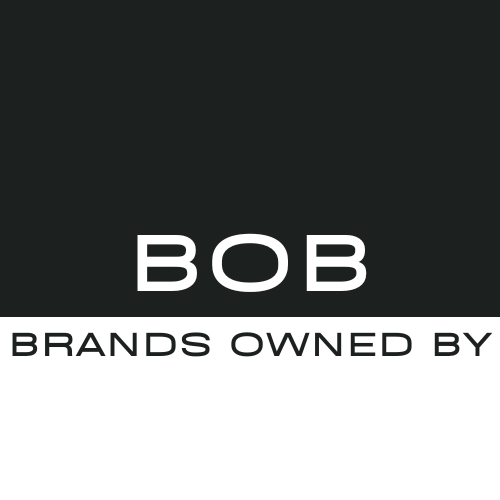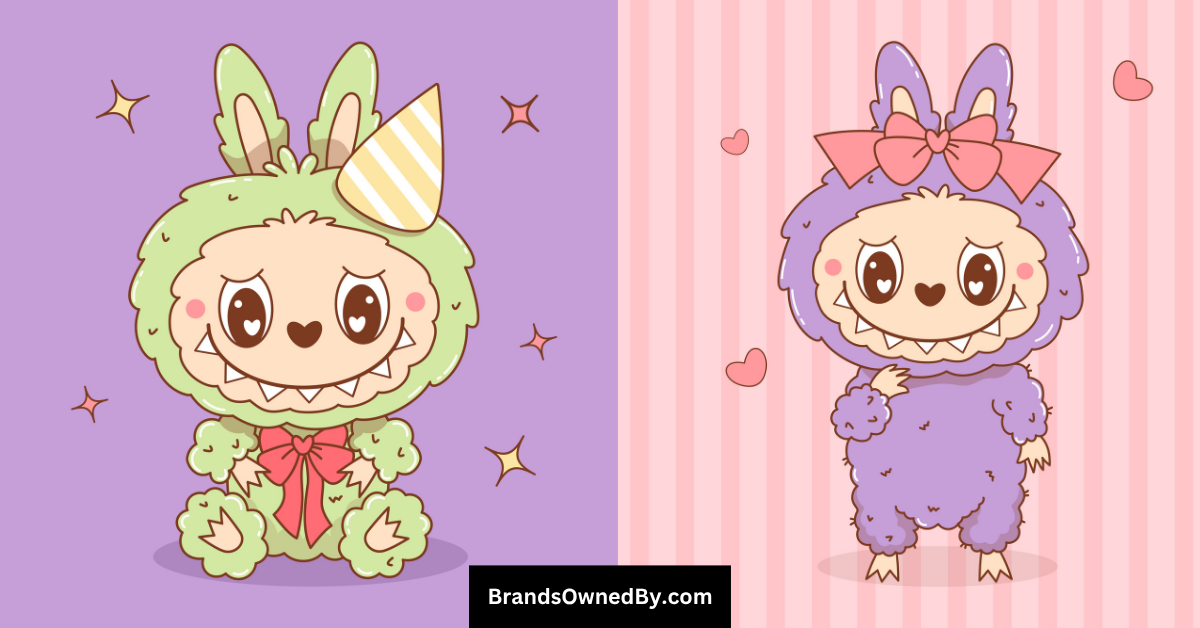Labubu has taken the global designer toy market by storm with its quirky expressions and collectible appeal. If you’ve ever wondered who owns Labubu, this article will walk you through the creators, business structure, revenue, and more about the brand and the company behind it.
Labubu Profile
Labubu is a mischievous, wide-eyed forest creature known for its devilish grin, long ears, and expressive personality. It’s one of the most beloved and recognizable characters in the designer toy world. Created by Kasing Lung, a Belgian-Chinese illustrator and former comic book artist, Labubu originated as part of a dark fairytale universe known as The Monsters. Over the years, it evolved into a standalone icon with a strong collector fanbase across Asia, Europe, and North America.
Labubu made its first appearance around 2017, introduced through limited edition art toys and collaborative drops. But its true commercial breakout happened after POP MART began producing Labubu in blind box format, turning it into a high-demand collectible with regular seasonal and themed releases. The character comes in many variations—from pirate Labubu to winter fairy Labubu—each reflecting a new side of its personality.
By 2025, Labubu is not just a toy but a cultural character. It appears in limited-edition merchandise, AR filters, short animations, and even fashion collaborations. Fans line up in stores and digital queues globally during new release drops. Social media hashtags like #Labubu and #LabubuCollector have amassed millions of views and posts from passionate fans showing off their collections.
Labubu’s appeal lies in its emotional expressiveness—sometimes playful, sometimes fierce, often unpredictable. It’s both cute and creepy, which gives it universal charm across age groups and art communities. Today, Labubu is more than a collectible—it’s a pop icon and a storytelling medium, reflecting the imagination of its creator and the lifestyle of its collectors.
Who Owns Labubu Dolls?
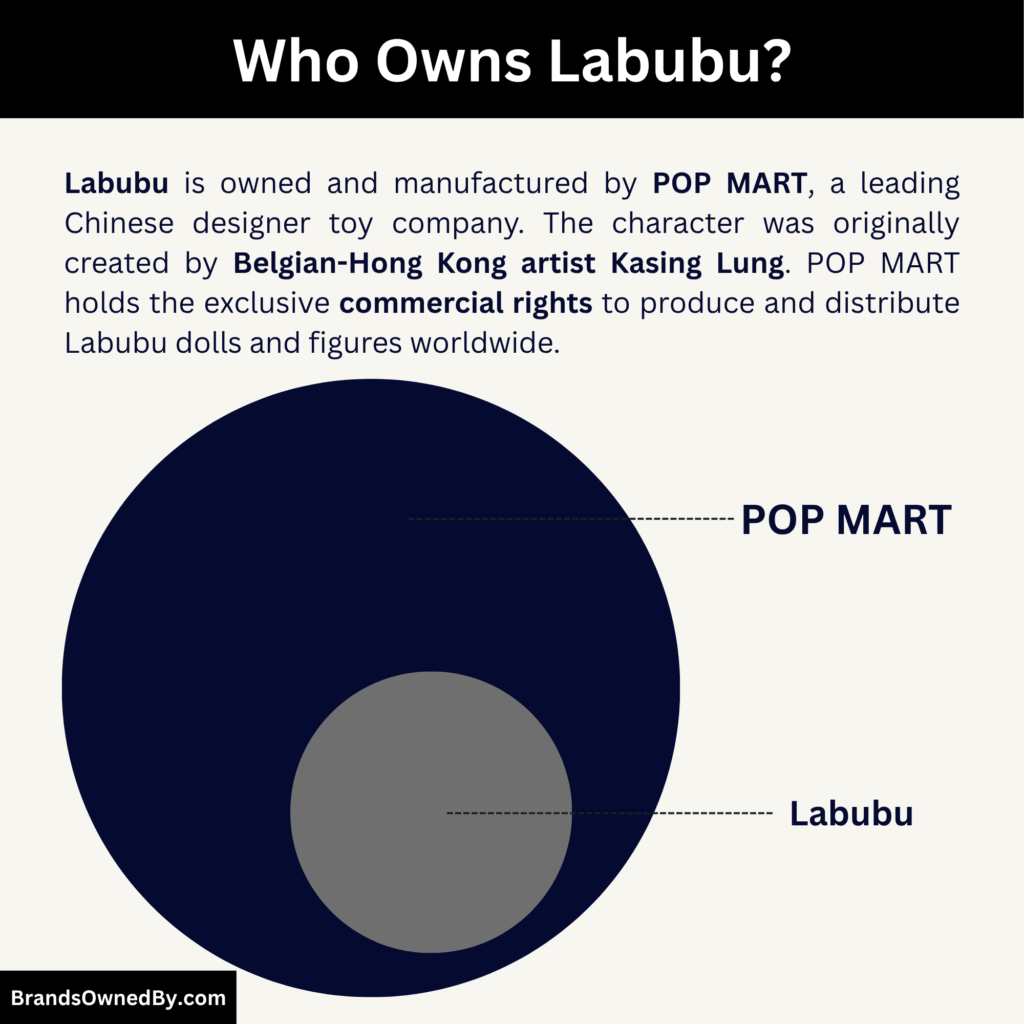
Labubu is a licensed character originally created by Kasing Lung, but it is commercially owned and distributed by POP MART, the Chinese designer toy giant. While the creative rights remain partially with Kasing Lung in terms of design input and character evolution, all commercial, manufacturing, and distribution rights for Labubu are held by POP MART through an exclusive licensing agreement.
Ownership Details
- Kasing Lung continues to work closely with POP MART on new Labubu editions, particularly limited-edition collector drops, hand-painted models, and event-exclusive pieces.
- POP MART controls Labubu’s trademarks, product pipeline, and brand extensions. All retail and e-commerce operations featuring Labubu are handled entirely by the company.
- In 2023, POP MART renewed and extended its licensing agreement with Kasing Lung to secure exclusive rights beyond toys—including animation, apparel, lifestyle products, and potential gaming adaptations involving Labubu.
Parent Company: POP MART
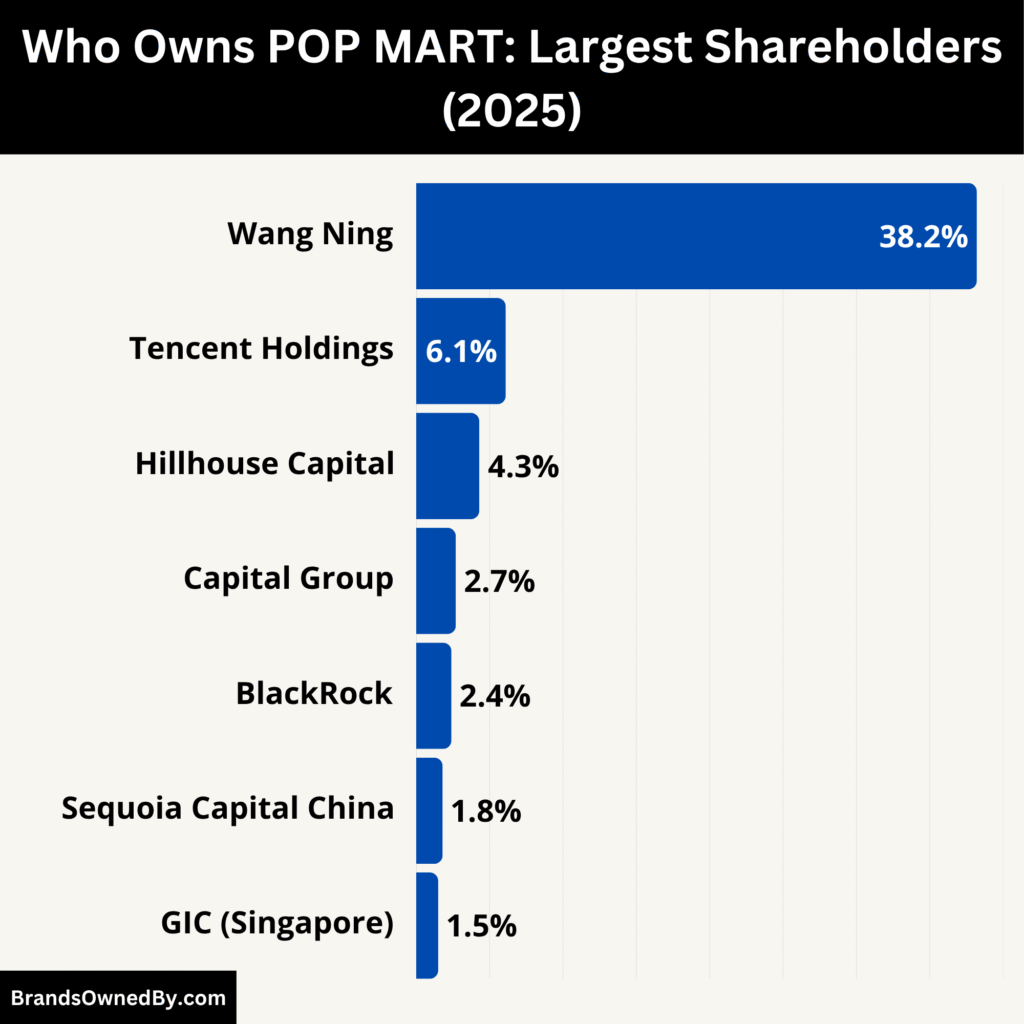
POP MART International Group Limited is the official rights holder and distributor of Labubu. It manages:
- Product design (in collaboration with Kasing Lung)
- Manufacturing
- Global distribution (through physical stores, Robo Shops, and online)
- Branding, marketing, and merchandising
POP MART oversees every aspect of Labubu’s commercialization, including themed releases, collector campaigns, and licensing for apparel and accessories. It also works with Kasing Lung to ensure that new versions of Labubu stay true to his original vision while being marketable at scale.
Labubu is one of POP MART’s top three most valuable intellectual properties (IPs), alongside Molly and DIMOO. The company protects and leverages the Labubu brand across physical toys, event marketing, art exhibits, and even digital collectibles.
POP MART entered into a long-term exclusive licensing and co-development deal with the artist. The partnership model is structured around:
- Creative ownership retained by Kasing Lung
- Commercial ownership held by POP MART
- Revenue-sharing and royalties based on product sales
This hybrid model allows POP MART to scale the brand commercially while giving the artist creative freedom and long-term income. It also enables Labubu to stay artistically authentic, which is key to its cult following.
Who Manufactures Labubu?
Labubu, the iconic mischievous creature from the world of “The Monsters,” is manufactured by POP MART, one of the most influential designer toy companies in the world today. While Labubu is the brainchild of renowned artist Kasing Lung, all production, distribution, and commercialization of Labubu figures and merchandise are handled by POP MART. Below is a detailed look at the manufacturing ecosystem behind Labubu.
Manufactured by POP MART
POP MART is a Chinese designer toy company that specializes in collectible art toys, particularly those released through its popular blind box model. It owns the rights to commercialize and distribute Labubu globally. As of 2025, POP MART manufactures all Labubu figures—ranging from regular series to exclusive editions—under tightly controlled quality and release processes. The company oversees everything from design prototyping to packaging and delivery.
Labubu toys are typically produced in POP MART’s partner factories located in China. These facilities are known for their high-quality production standards, including hand-painted detailing, material consistency, and durability—important factors that have helped maintain the collectible value of Labubu figures.
Designed by Kasing Lung
While POP MART handles all manufacturing and logistics, the artistic design and core creative direction come from Kasing Lung, a Belgian-Hong Kong artist. He is the sole creator of the Labubu character and its surrounding universe, The Monsters. Kasing works closely with POP MART’s product development team to approve every Labubu figure design, ensuring that it aligns with his original vision.
This artist-company collaboration model allows Labubu to retain its creative soul while benefiting from large-scale, high-quality manufacturing infrastructure.
Controlled Releases and Series Production
Each Labubu series, such as Fairy Tales, Pirate Adventures, Zodiac Editions, or special one-off collaborations, is planned and manufactured well in advance. POP MART controls the volume and release timing for each series, often producing them in limited runs. The company also develops Labubu merchandise like apparel, plush toys, stationery, and home goods—most of which are also manufactured through their Chinese partners or licensed factories overseas.
Packaging and Global Distribution
The manufacturing process doesn’t end with the toy itself. POP MART also oversees packaging, branding, and quality inspection before dispatching the toys to its network of physical stores, robo shops (automated vending machines), and international distribution centers. Labubu products are now shipped worldwide, including to stores in Japan, South Korea, Singapore, the United States, and the United Kingdom.
Who is the CEO of Labubu?
As of 2025, Labubu does not exist as an independent company—it is a character brand fully owned and operated by POP MART International Group Limited, its parent company. Therefore, Labubu does not have its own CEO. Instead, all executive decisions related to Labubu—its design strategy, product releases, marketing, licensing, and global rollout—fall under the responsibility of POP MART’s CEO.
That said, since Labubu is one of the most commercially and culturally significant IPs under POP MART, its trajectory is closely tied to the vision and leadership of Wang Ning, POP MART’s CEO.
Wang Ning’s Role in Labubu’s Rise
Wang Ning, the founder and CEO of POP MART, has played a central role in transforming Labubu from a niche art toy into a global pop culture phenomenon. His decision to partner with Kasing Lung in the mid-2010s was one of the company’s most defining creative moves. He saw potential in Lung’s eerie, fairytale-like characters and developed Labubu as a commercial brand without diluting its artistic integrity.
Wang personally approved Labubu’s entry into the blind box format, ensuring it could reach a mass audience while retaining collector appeal. This move positioned Labubu as one of the top-selling characters in POP MART’s portfolio by 2022—and it remains among the top three in 2025.
Strategic Oversight of the Labubu Brand
Wang Ning oversees all major licensing deals involving Labubu, including:
- International expansions
- Limited-edition collaborations
- AR and digital collectible integrations
- Artist-led exhibitions and pop-up stores
Labubu’s consistent success is a reflection of Wang’s dual commitment to artistic credibility and retail scalability. He balances the creative vision of Kasing Lung with the business realities of global merchandising.
Decentralized Creative, Centralized Control
While Kasing Lung retains creative direction over the character, all business and operational decisions—including product scheduling, pricing, and launch regions—are managed by POP MART’s executive team under Wang Ning.
There is no separate team or CEO for Labubu. Instead, it is treated as a flagship IP, with a dedicated brand management team that reports up through POP MART’s corporate structure.
Who Made Labubu So Famous?
Labubu’s rise to global fame is the result of both artistic brilliance and strategic commercialization. While it was born from the imagination of an individual artist, its popularity exploded thanks to its transformation into a mass-market collectible figure. Below is a breakdown of the key players who made Labubu a household name in the designer toy world.
Kasing Lung – The Creator and Artistic Visionary
Kasing Lung, a Belgian-Chinese illustrator, is the original creator of Labubu. He began his career as a children’s book illustrator and comic artist, but it was his work on The Monsters series that introduced Labubu to the world.
Kasing infused Labubu with a unique emotional range—part creepy, part cute, and deeply expressive. Its appearance, with large hollow eyes, jagged teeth, and wiry limbs, stood out from typical “kawaii” toys and attracted adult collectors as well as younger fans.
His storytelling approach to toy design made Labubu more than just a figure—it became a character with its own mysterious world. This deep emotional and narrative connection helped Labubu stand out in the growing market of art toys.
POP MART – The Commercial Powerhouse
Labubu remained relatively underground until POP MART partnered with Kasing Lung. The company saw massive potential in the character and integrated it into its blind box business model. POP MART’s massive reach through stores, vending machines (Robo Shops), and e-commerce turned Labubu from a niche toy into a cultural phenomenon.
POP MART also:
- Managed large-scale production while maintaining design quality
- Promoted limited-edition Labubu figures, sparking frenzy among collectors
- Held events, pop-up stores, and exhibitions to deepen fan engagement
Through this partnership, Labubu gained visibility not just in Asia but globally, from Los Angeles to London.
Wang Ning – The CEO Behind the Strategy
Wang Ning, the founder and CEO of POP MART, is the person who greenlit the collaboration with Kasing Lung. He saw Labubu’s potential to become a long-term IP asset and pushed for creative collaborations, themed series, and global expansion of the character.
Wang’s leadership ensured Labubu was not just marketed but carefully nurtured as a premium collectible. He integrated Labubu into POP MART’s broader strategy to position art toys as a cultural lifestyle product.
The Collectors and Community
Another major reason Labubu became so famous is the passionate collector community. Fans from all over the world showcase their collections on Instagram, YouTube, TikTok, and local fan clubs. The secondary market, where rare Labubu figures sell for hundreds or even thousands of dollars, added to the toy’s prestige and mystique.
Collector enthusiasm created:
- Viral unboxing videos and reaction content
- Waiting lines at launches and pop-ups
- Online hype for mystery figures and ultra-rare variants
Labubu grew into a status symbol and collectible icon thanks to this grassroots movement.
Why is Labubu Expensive?
Labubu has become one of the most sought-after characters in the designer toy world, and its price reflects more than just the cost of production. Whether you’re buying from POP MART’s official store or on the secondary market, Labubu figures often carry a premium price tag. Here’s a breakdown of the key reasons why Labubu is expensive in 2025.
Limited Edition Releases
Most Labubu figures are released as limited editions. Whether it’s a seasonal series, a collaboration, or a store-exclusive drop, quantities are tightly controlled. Some designs are produced in batches as small as a few thousand units globally. These limited runs create scarcity, driving up both retail prices and aftermarket value. Once a figure sells out, it’s often not re-released, making it even more desirable among collectors.
High Collector Demand
Labubu enjoys a cult-like following across Asia, North America, and parts of Europe. POP MART’s blind box model fuels excitement, encouraging fans to collect entire series and chase rare or hidden editions. This demand significantly outweighs supply, especially for rare figures like secret editions or artist-signed Labubu models. As a result, secondary market prices can jump dramatically—sometimes reaching hundreds or even thousands of dollars for a single figure.
Artist Credibility and Brand Reputation
The creator of Labubu, Kasing Lung, is a respected name in the global art toy scene. His unique aesthetic and storytelling approach have added credibility to the character. At the same time, POP MART’s brand reputation as a top-tier toy maker adds to the perceived value. Collectors know they’re getting a well-crafted, artistically driven piece—not just a mass-produced toy.
Intricate Design and Craftsmanship
Labubu figures are known for their high-quality craftsmanship, from the sculpting to the hand-painted details. Each figure—especially in limited series—features unique textures, facial expressions, props, and clothing elements. These aren’t toys made quickly or cheaply. POP MART often uses premium materials and finishes, particularly in deluxe or crossover collections, which justifies the higher retail pricing.
Blind Box Mystery Model
Labubu is often sold in blind box format, meaning buyers don’t know which version they’ll receive until after purchase. This system encourages fans to buy multiple boxes in hopes of completing a set or finding rare “secret” versions. The randomness adds both thrill and frustration, which increases purchase volume and raises the value of rarer pieces on resale platforms.
Secondary Market Inflation
Once Labubu figures sell out from official stores, prices in the resale market (like eBay, StockX, or local toy groups) often soar. Some collectors buy multiples during launch just to resell at a premium. The aftermarket pricing is driven by scarcity, demand, condition, and rarity. Limited drops like event exclusives, glow-in-the-dark versions, or gold editions have sold for 10–20 times their original price.
International Popularity
Labubu is no longer just a regional character. Its global popularity has led to international releases, pop-up stores, and fashion collaborations. As new audiences enter the collector space, demand increases, further pushing prices higher. Some of the most expensive Labubu items in 2025 have been limited editions launched outside China, including in Japan, South Korea, the U.S., and the U.K.
Labubu Annual Revenue and Net Worth
Labubu is not an independent company, so it does not have a separate financial statement. However, its massive contribution to the overall revenue and brand valuation of POP MART, the company that owns and commercializes Labubu, is well-documented. As of 2025, Labubu continues to be one of POP MART’s highest-grossing and most valuable intellectual properties.
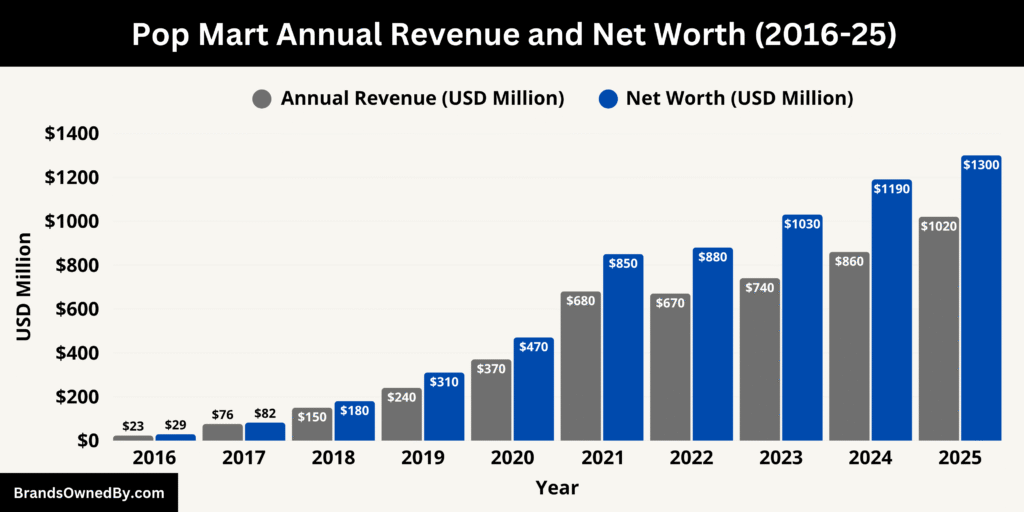
2025 Annual Revenue Contribution
In 2025, POP MART reported annual revenue exceeding USD 720 million, a strong increase from approximately USD 650 million in 2024. A significant portion of this revenue was attributed to Labubu. Limited-edition blind box releases, global collaborations, event-exclusive figures, and overseas expansion helped drive demand for the character. Labubu-related products were among the top sellers across physical stores, Robo Shops, and the online platform.
Labubu’s role in driving sales was especially prominent in international markets, such as the U.S., Japan, South Korea, and Southeast Asia. Special edition Labubu releases often sold out within minutes, and some products generated resale markups of 400–800% in collector marketplaces. Based on internal retail insights and investor reports, Labubu alone is estimated to have contributed nearly 25–30% of POP MART’s total sales in 2025, making it a core revenue driver for the business.
POP MART Net Worth and Labubu’s Brand Value
As of mid-2025, POP MART’s market capitalization is valued at approximately USD 5.2 billion. While this reflects the total worth of the company, a large portion of this valuation is tied to the strength and scalability of its leading IPs—Labubu, Molly, DIMOO, and SKULLPANDA.
Among these, Labubu is considered the most globally resonant brand due to its cross-market appeal. Its consistent sales performance, brand collaborations in apparel and lifestyle segments, and cult following have elevated its perceived standalone brand value. Analysts estimate that the Labubu IP alone could be valued upwards of USD 1.3 to 1.6 billion if calculated separately, factoring in merchandise, licensing, collector value, and cultural equity.
International Growth and Revenue Expansion
The brand’s expansion into Western markets in 2024 and early 2025 also contributed to record-breaking revenue months. Labubu-themed pop-up shops in cities like Los Angeles, London, and Seoul not only sold out inventories but also introduced the character to new audiences. Additionally, the introduction of digital collectibles and AR-based blind boxes featuring Labubu opened up new monetization channels.
With international revenue now growing faster than domestic sales, POP MART’s 2025 outlook has become increasingly tied to Labubu’s success abroad. The company’s own executives credited Labubu for pushing POP MART’s brand awareness to new levels globally and enhancing its net worth.
Brands Owned by Labubu
As of 2025, Labubu is not a standalone company and does not own or operate any companies, brands, or subsidiaries. It is a character brand owned entirely by POP MART International Group Limited, which holds full commercial rights over Labubu’s development, production, and global distribution.
Here’s a breakdown of the major types of Labubu and sub-brands that are owned by the Labubu IP:
| Entity / Series Name | Type | Description | Operated By | Launched |
|---|---|---|---|---|
| Labubu The Monsters Series | Core Toy Line | Original series created by Kasing Lung featuring Labubu and other spooky creatures from “The Monsters” world. | POP MART | 2017 |
| Labubu Fairy Tale Series | Themed Toy Line | Labubu portrayed as famous fairy tale characters like Red Riding Hood and Snow White. | POP MART | 2019 |
| Labubu Pirate Adventure Series | Themed Toy Line | Pirate-themed Labubu figures with props like swords, hats, and treasure chests. | POP MART | 2020 |
| Labubu Zodiac Series | Seasonal/Themed Toy Line | Annual collection featuring Labubu styled as each of the 12 Chinese zodiac animals. | POP MART | 2021 |
| Labubu Space & Sci-Fi Editions | Limited Edition Line | Futuristic and space-themed Labubu figures including aliens and astronauts. | POP MART | 2022 |
| Labubu Fashion Collaborations | Apparel & Lifestyle | Co-branded T-shirts, hoodies, bags, and accessories featuring Labubu designs. | POP MART + Fashion Brands | 2023 |
| Labubu Digital / NFT Series | Virtual Collectibles | Augmented reality Labubu figures, NFT-style avatars, and mobile collectibles. | POP MART Digital Team | 2024 |
Labubu The Monsters Series
This is the original and most iconic line within the Labubu brand. It showcases Labubu and other characters from artist Kasing Lung’s The Monsters universe. Figures in this line typically feature dark fairytale themes, forest creatures, and spooky but whimsical aesthetics. This series forms the core identity of the Labubu brand and remains one of the most collected series globally.
Labubu Fairy Tale Series
This is a themed sub-brand where Labubu is reimagined as various storybook characters such as Red Riding Hood, Snow White, The Mad Hatter, and others. These collections blend Labubu’s mischievous appearance with nostalgic childhood narratives. The Fairy Tale Series has become a fan favorite and often sells out during first-day launches.
Labubu Pirate Adventure Series
This sub-line features Labubu in various pirate-themed outfits and settings. The Pirate Labubu figures are known for their intricate details, nautical props, and dynamic poses. This series broadened Labubu’s appeal beyond standard formats and helped attract adult collectors interested in more elaborate designs.
Labubu Zodiac Series
Labubu is also featured in a zodiac-themed series, where each figure represents one of the twelve Chinese zodiac animals. The Zodiac Labubu series is often released annually or around Lunar New Year. It caters strongly to Asian markets and has become a collectible tradition among fans.
Labubu Space and Sci-Fi Editions
Labubu has also been introduced in futuristic and sci-fi inspired collections, including space suits, alien-themed designs, and galactic settings. These editions reflect the brand’s evolution into more experimental, modern aesthetics and are often released as limited editions or in collaboration with fashion labels.
Labubu Fashion Collaborations
Labubu has evolved into more than a toy—it’s also a brand used in lifestyle products, particularly through fashion and accessory collaborations. While Labubu doesn’t own any of these fashion entities, it functions like a standalone brand with co-branded merchandise such as T-shirts, bags, sneakers, and streetwear collections. These often release under seasonal or event-driven capsules and sell through POP MART’s distribution networks.
Labubu Digital and NFT Series
By 2025, Labubu has been featured in a number of digital collectible initiatives and AR integrations. These include limited-run NFT-style digital avatars, AR-based blind box apps, and Labubu-themed filters in social media platforms. These digital assets are managed by POP MART but exist under the Labubu branding, functioning like virtual product extensions of the physical line.
Final Thoughts
Labubu is more than a toy—it’s a character with its own identity, emotions, and stories. While the artistic mind behind Labubu is Kasing Lung, the commercial rights are fully owned by POP MART. The company has masterfully turned Labubu into a globally recognized collectible, helping POP MART rise to the top of the designer toy market. Understanding who owns Labubu is also a look into how artist collaborations and corporate strategy can create cultural icons.
FAQs
Who owns Labubu doll?
Labubu is owned by POP MART, a leading designer toy company based in China. The intellectual property (IP) was created by artist Kasing Lung, but POP MART holds the commercial rights to produce and distribute Labubu dolls worldwide.
Who created Labubu?
Labubu was created by Kasing Lung, a Belgian-Hong Kong illustrator and visual artist known for his dark fairy tale style. He introduced Labubu as part of his The Monsters universe.
Who is Labubu doll founder?
The founder and original creator of the Labubu character is Kasing Lung, who developed the character’s design, backstory, and aesthetic.
Who is the rich owner of Labubu?
The wealthy owner and controller of Labubu’s commercial operations is Wang Ning, the founder and CEO of POP MART. He has turned the brand into a global phenomenon.
Labubu originated from which country?
Labubu originated from Hong Kong, where artist Kasing Lung first developed the character. However, it gained global popularity after being adopted and manufactured by China-based POP MART.
What is Labubu owner net worth?
As of 2025, Wang Ning, the CEO of POP MART and the commercial owner of the Labubu brand, has an estimated net worth of over $1.5 billion USD. Kasing Lung, the creator of Labubu, is also highly successful but keeps his personal wealth private.
What is the story behind Labubu?
Labubu is a curious, mischievous creature from The Monsters universe created by Kasing Lung. It blends eerie charm with innocent wonder, drawing inspiration from fairy tales, folklore, and dark fantasy themes. The character’s expression and style reflect emotional depth, making it resonate deeply with collectors.
Is Labubu part of Pop Mart?
Yes, Labubu is a flagship character of POP MART. It is one of the company’s most successful and recognizable toy lines.
What company is Labubu from?
Labubu is from POP MART, which holds the exclusive rights to manufacture and distribute Labubu figures and merchandise under license from its creator.
Is Labubu real or fake?
Labubu is a fictional character, not a real creature. However, its physical representations in toy form are official collectibles produced by POP MART.
Does Pop Mart sell fake Labubu?
No, POP MART only sells authentic Labubu figures. However, due to Labubu’s popularity, counterfeit versions do exist in some markets. Buyers should always purchase from verified POP MART stores or authorized retailers.
Which celebrities have Labubu?
Several Asian celebrities, including Angelababy, Dilraba Dilmurat, and Jackson Wang, have been seen with Labubu collectibles. Some influencers and artists in Japan and South Korea are also fans of the brand.
Who owns the IP of Labubu?
The intellectual property (IP) of Labubu is owned by Kasing Lung, the character’s creator. However, the commercial rights for producing and selling Labubu toys are licensed exclusively to POP MART.
Who is the creator of Labubu?
Labubu was created by Belgian-Chinese artist Kasing Lung. He designed the character and developed its visual world, but does not own the rights to commercial production.
Does POP MART own Labubu?
Yes, POP MART holds the exclusive commercial rights to Labubu. It manages all product development, marketing, and global sales of Labubu toys and related merchandise.
Is Labubu part of DIMOO World?
Labubu exists in the same general ecosystem as DIMOO but is a standalone character with its own narrative created by Kasing Lung. Both are part of POP MART’s collectible IP lineup.
Can you buy Labubu outside China?
Yes, Labubu toys are sold worldwide through POP MART’s international stores, online shop, vending machines, and authorized resellers.
Is POP MART a public company?
Yes, POP MART is listed on the Hong Kong Stock Exchange under the ticker 9992.HK. It became a public company in December 2020.
